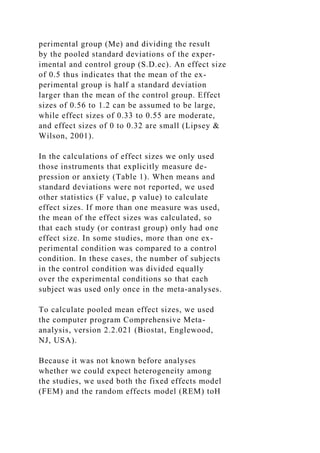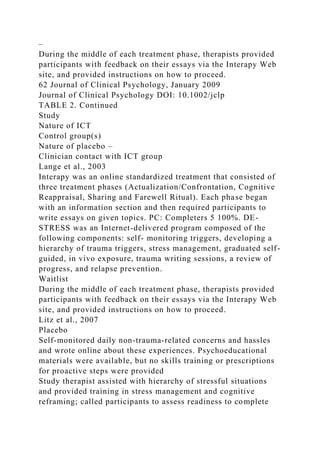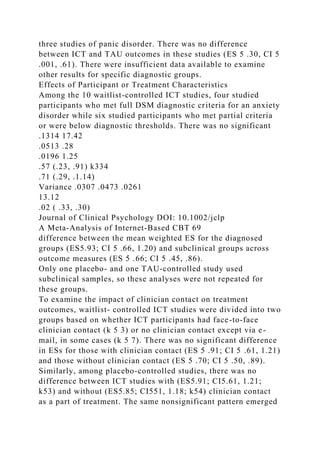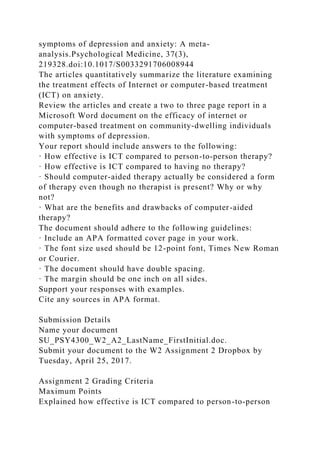This meta-analysis reviews the effectiveness of internet-based cognitive behavioral therapy (CBT) for symptoms of depression and anxiety across 12 randomized controlled trials involving 2,334 participants. The findings indicate a moderate to large overall effect size for internet-based CBT, with significant variations in effects based on symptom type and therapist support, showing larger effects for anxiety than depression. Interventions with therapist assistance yielded better outcomes compared to those without support, highlighting the importance of therapist involvement in treatment efficacy.
![REVIEW ARTICLE
Internet-based cognitive behaviour therapy for symptoms
of depression and anxiety: a meta-analysis
VIOLA SPEK1 ,2*, PIM CUIJPERS 3, IVAN NYKLÍČEK1,
HELEEN RIPER4,
JULES KEYZER 2 A N D VICTOR POP 1,2
1 Department of Psychology and Health, Tilburg University,
The Netherlands; 2 Diagnostic Centre Eindhoven,
The Netherlands; 3 Department of Clinical Psychology, Vrije
Universiteit Amsterdam, The Netherlands;
4 Trimbos-instituut, Netherlands Institute of Mental Health and
Addiction, The Netherlands
ABSTRACT
Background. We studied to what extent internet-based cognitive
behaviour therapy (CBT)
programs for symptoms of depression and anxiety are effective.
Method. A meta-analysis of 12 randomized controlled trials.
Results. The effects of internet-based CBT were compared to
control conditions in 13 contrast
groups with a total number of 2334 participants. A meta-
analysis on treatment contrasts resulted in
a moderate to large mean effect size [fixed effects analysis
(FEA) d=0.40, mixed effects analysis
(MEA) d=0.60] and significant heterogeneity. Therefore, two](https://image.slidesharecdn.com/reviewarticleinternet-basedcognitivebehaviourtherapyf-221031144946-951773b4/85/REVIEW-ARTICLEInternet-based-cognitive-behaviour-therapy-f-docx-1-320.jpg)

![use has even spread among the groups that
are not usually the first to use a new technology,
namely women, elderly people and minority
groups (Lamerichs, 2003). The expansion of the
internet offers new treatment opportunities.
CBT is very suitable for adaptation to a com-
puter format. It is a structured treatment ap-
proach with the aim of developing new types of
behaviour and cognition.
Internet-based CBT has advantages over tra-
ditional CBT for both clients and health care.
* Address for correspondence: Viola Spek, Tilburg University,
PO Box 90153, 5000 LE Tilburg, The Netherlands.
(Email: [email protected])
Psychological Medicine, 2007, 37, 319–328. f 2006 Cambridge
University Press
doi:10.1017/S0033291706008944 First published online 20
November 2006 Printed in the United Kingdom
319
The anonymity and accessibility of the internet
make it very suitable for offering and receiving
help with psychological problems. Clients who
are treated on the internet can avoid the stigma
incurred by seeing a therapist (Gega et al. 2004).
They can obtain treatment at any time and
place, work at their own pace, and review the
material as often as desired. In internet-based
treatment, clients are guided by programs to
work on their problems. The level of therapist](https://image.slidesharecdn.com/reviewarticleinternet-basedcognitivebehaviourtherapyf-221031144946-951773b4/85/REVIEW-ARTICLEInternet-based-cognitive-behaviour-therapy-f-docx-3-320.jpg)











































![RESULTS
A fixed effects meta-analysis on all contrasts was
conducted (Fig. 2, Table 2), resulting in a mean
effect size of 0.24 [95% confidence interval (CI)
0.16–0.33], while the REM resulted in a mean
effect size of 0.51 (95% CI 0.28–0.74). The hy-
pothesis of homogeneity was rejected because
a significant Q value was found (Q=58.65, I2=
79.5%). We examined possible sources of het-
erogeneity through post hoc subgroup analy-
ses. A subgroup analysis based on the aim of
the intervention (prevention or treatment) still
324 V. Spek et al.
showed high heterogeneity among treatment
studies (n=11, Q=39.77, I2=74.9%) but not
among prevention studies (n=2, Q=1.43, I2=
30.2%). Treatment studies were then further
divided into two sets of subgroups: one set based
on the symptoms that were treated and one
set based on the inclusion of support in the
interventions. These divisions are depicted in
Fig. 3, for purposes of clarity prevention studies
are not included in this figure.
The studies on depression (n=5) had a mean
effect size of 0.27 (95% CI 0.15–0.40) according
to the FEA and 0.32 (95% CI 0.08–0.57)
according to the MEA. The Q value was 13.37](https://image.slidesharecdn.com/reviewarticleinternet-basedcognitivebehaviourtherapyf-221031144946-951773b4/85/REVIEW-ARTICLEInternet-based-cognitive-behaviour-therapy-f-docx-47-320.jpg)










![Gega, L., Marks, I. & Mataix-Cols, D. (2004). Computer-aided
CBT
self-help for anxiety and depressive disorders: experience of
a London clinic and future directions. Journal of Clinical
Psychology/In Session 60, 147–157.
Higgins, J. P. T. & Green S. (eds) (2005). Cochrane Handbook
for
Systematic Reviews of Interventions 4.2.5 [updated May 2005].
In The Cochrane Library, Issue 3. John Wiley: Chichester.
Higgins, J. P. T., Thompsin, S. G., Deeks, J. J. & Altman, D. G.
(2003). Measuring inconsistency in meta-analyses. British
Medical
Journal 327, 557–560.
Hirai, M. & Clum, G. A. (2005). An internet-based self-change
pro-
gram for traumatic event related fear, distress, and maladaptive
coping. Journal of Traumatic Stress 18, 631–636.
Internet-based cognitive behaviour therapy 327
Hollon, S. D., Stewart, M. O. & Strunk, D. (2006). Enduring
effects
for cognitive behavior therapy in the treatment of depression
and
anxiety. Annual Review of Psychology 57, 285–315.
Kenardy, J., McCafferty, K. & Rosa, V. (2003). Internet-
delivered
indicated prevention for anxiety disorders: a randomised
controlled trial. Behavioural and Cognitive Psychotherapy 31,](https://image.slidesharecdn.com/reviewarticleinternet-basedcognitivebehaviourtherapyf-221031144946-951773b4/85/REVIEW-ARTICLEInternet-based-cognitive-behaviour-therapy-f-docx-58-320.jpg)


![School of Medicine
Gregory A. Gahm
Madigan Army Medical Center
Internet-and computer-based cognitive-behavioral treatments
have been introduced as novel approaches to deliver standard,
quality treatment that may reduce barriers to care. The purpose
of this review is to quantitatively summarize the literature
examining the treatment effects of Internet- or computer-based
treatment (ICT) on anxiety. Nineteen randomized controlled
ICT trials were identified and subjected to fixed and random
effects meta-analytic techniques. Weighted mean effect sizes
(Cohen’s d) showed that ICT was superior to waitlist and
placebo assignment across outcome measures (ds5.49–1.14).
The effects of ICT also were equal to therapist-delivered
treatment across anxiety disorders. However, conclusions were
limited by small sample sizes, the rare use of placebo controls,
and other methodological problems. In addition, the number of
available studies limited the opportunity to conduct analyses by
diagnostic group; there was preliminary support for the use of
ICT for panic disorder and phobia. Large, well-designed,
placebo-controlled trials are needed to confirm and extend the
results of this meta-analysis. & 2008 Wiley Periodicals, Inc. J
Clin Psychol 65: 53–75, 2009.
Keywords: Internet; computer; cognitive-behavioral therapy;
meta- analysis; anxiety
Dozens of randomized, controlled clinical trials have
demonstrated that cognitive- behavioral therapy (CBT)
improves symptoms of anxiety (Deacon & Abramowitz, 2004;
Scott, 2001). Despite this body of research, multiple factors still
limit the utility
Correspondence concerning this article should be addressed to:
Gregory Gahm, Ph.D., Director, Telehealth and Technology
Directorate, Defense Centers of Excellence for Psychological
Health and Traumatic Brain Injury, Bldg. 9040, Fitzsimmons
Drive, Attn: OMAMC 9933A, Tacoma, WA 98431- 1100; e-
mail: [email protected]](https://image.slidesharecdn.com/reviewarticleinternet-basedcognitivebehaviourtherapyf-221031144946-951773b4/85/REVIEW-ARTICLEInternet-based-cognitive-behaviour-therapy-f-docx-61-320.jpg)




![excluded when the computer hardware used to conduct the
treatment required more than a PC and an Internet connection.
Thus, studies utilizing equipment such as a virtual reality head
mount display were excluded. Three studies were identified that
appeared to meet inclusion criteria, but did not report sufficient
statistical information for the computation of an ES. Letters
were sent to the corresponding authors of these studies
requesting additional information; one response was received,
allowing the study to be included (Klein & Richards, 2001). The
final results of the literature search produced 19 studies that
met the aforementioned criteria. A list of excluded studies is
available upon request. Participant characteristics and ICT
treatment details for each study are presented in Tables 1 and 2,
respectively.
Methodological Quality
The methodological quality of each included primary study was
rated utilizing a rating scheme recommended in a recent review
of systems available for rating the strength of scientific
evidence (West et al., 2002). The methodological ratings of the
RCTs were based on four broad categories (study population,
interventions, measurement of effect, and data presentation) that
were divided into specific weighted criteria based on each
criterion’s importance for validity and clinical relevance (van
der Heijden, van der Windt, Kleijnen, Koes, & Bouter, 1996).
Specific criteria were modified when the characteristics of
interest were specific to medical RCTs in the original system.
The detailed criteria utilized in this study are available upon
request. Briefly, studies were rated based upon (a) patient
selection [possible points (pp) 5 4], (b) randomization
procedure (pp 5 5), (c) sample size (pp 5 15), (d) comparability
of groups (pp 5 6), (e) management of dropouts (pp 5 6), (f)
rates of loss-to-follow-up (pp 5 5), (g) description of treatments
(pp 5 8), (h) management of co-interventions (pp54), (i)
blinding of patients (pp54), (j) relevant outcome measures
(pp56), (k) blinded outcome measurement (pp53), (l) duration of
follow-up (pp54), and (m) adequate analysis and presentation](https://image.slidesharecdn.com/reviewarticleinternet-basedcognitivebehaviourtherapyf-221031144946-951773b4/85/REVIEW-ARTICLEInternet-based-cognitive-behaviour-therapy-f-docx-66-320.jpg)
![(pp58). Thus, RCTs were rated on a total of 78 possible points.
Data Coding
The following information was extracted from the published
articles for each coded effect: (a) number of participants and
their demographics, (b) participants’ diagnosis, (c) nature of
ICT, (d) type of control group used [waitlist, placebo, or
therapist-delivered treatment as usual (TAU)], (e) outcome
measures administered, (f) summary statistics required for
computation of ESs, and (g) amount of clinician contact during
ICT.
Outcome measures were categorized into the following five
domains: Depression, Anxiety, General Distress, Dysfunctional
Thinking, and Functioning/Quality of Life. Each measure was
coded in a single domain that was judged to best represent the
primary area measured. Measures of functional abilities and
quality of life were grouped together based on research showing
that functional skills are a primary component of quality of life
(Quilty, Van Ameringen, Mancini, Oakman, & Farvolden,
2003). Table 3 lists the tests that were included in each outcome
domain.
Journal of Clinical Psychology DOI: 10.1002/jclp
A Meta-Analysis of Internet-Based CBT 57
Journal of Clinical Psychology DOI: 10.1002/jclp
Table 1
Participant Characteristics in Primary Studies
Study N Andersson
69% had at least some college
–
Recruited by means of newspaper and magazine articles, and an
Internet link
Social Phobia
et al., 2006
Carlbring et al., 2005
Recruited from a waitlist of individuals interested in Internet
treatment.
Met DSM-IV criteria for a diagnosis of panic disorder](https://image.slidesharecdn.com/reviewarticleinternet-basedcognitivebehaviourtherapyf-221031144946-951773b4/85/REVIEW-ARTICLEInternet-based-cognitive-behaviour-therapy-f-docx-67-320.jpg)


























